#pullman union
Explore tagged Tumblr posts
Text
Is antitrust anti-labor?
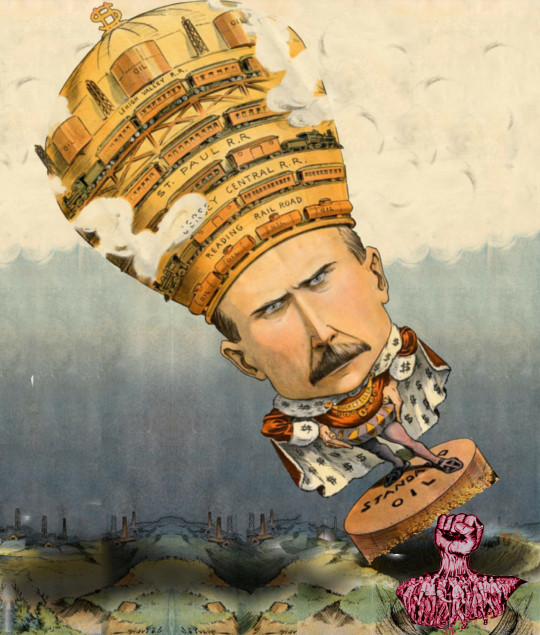
If you find the word “antitrust” has a dusty, old-fashioned feel, that’s only to be expected — after all, the word has its origins in the late 19th century, when the first billionaire was created: John D Rockefeller, who formed a “trust” with his oil industry competitors, through which they all agreed to stop competing with one another so they could concentrate on extracting more from their workers and their customers.
If you’d like an essay-formatted version of this post to read or share, here’s a link to it on pluralistic.net, my surveillance-free, ad-free, tracker-free blog:
https://pluralistic.net/2023/04/14/aiming-at-dollars/#not-men
Trusts were an incredibly successful business structure. A bunch of competing companies would be sold to a new holding company (“the trust”), and the owners of those old standalone companies would get stock in this new trust. The trust would operate as a single entity, hiking prices and suppressing wages. If anyone tried fight the trust with a new, independent company, the trust could freeze them out, by selling goods below cost, or by doing exclusive deals with key suppliers and customers, or both. Once a trust sewed up an industry, no one could compete. The trust barons were rulers for life.
The first successful trust was Rockefeller’s Standard Oil, which amassed a 90% share of all US oil. Other “capitalists” got in on the game, forming the Cotton Seed Oil Trust (75% market share), the Sugar Trust (85%). Then came the Whiskey Trust and the Beef Trust. America was becoming a planned economy, run by a handful of unelected “industrialists” with lifetime appointments and the power to choose their successors.
A century after overthrowing the King, America had new kings: “kings over the production, transportation and sale of the necessities of life”. That’s how Senator John Sherman described the situation in 1890, when he was campaigning for the passage of the Sherman Act, the first “anti-trust” act. The Sherman Act wasn’t the first time American lawmakers tried to protect competition, but it was the first law passed after the failure of competition law led to the hijacking of the nation by people Sherman called the “autocrats of trade.”
https://marker.medium.com/we-should-not-endure-a-king-dfef34628153
The Sherman Act — and its successors, like the Clayton Act, are landmark laws in that they explicitly seek to protect workers and customers from corporate power. Antitrust is about making sure that no corporation gets so powerful that it’s too big to fail, nor too big to jail — that a company can’t get so big that it subverts the political process, capturing its own regulators:
https://doctorow.medium.com/small-government-fd5870a9462e
If American workers are derided as “temporarily embarrassed millionaires” who won’t join the fight against the rich because they assume they’ll soon join their ranks, then the American rich are “temporarily embarrassed aristocrats” who would welcome hereditary rule, provided they got to found one of the noble families. The goal of the American elite has always been to create a vast and durable dynasty, wealth so vast and well-insulated that even the most Habsburg-jawed failson can’t piss it away.
The American elite has always hated antitrust. In the 1980s, Ronald Reagan, abetted by Robert Bork and his co-conspirators at the Chicago School of Economics gutted antitrust through something called the “consumer welfare standard,” which ended anti-monopoly enforcement except in instances where price hikes could be directly and unarguably attributed to market power, which is, basically, never.
It’s been 40 years since Reagan took antitrust out behind the Lincoln Monument and shot it in the guts, and America has turned into the kind of aristocratic kleptocracy that Sherman railed against, where “great families” control the nation’s wealth and politics and even its Supreme Court judges:
https://pluralistic.net/2023/04/06/clarence-thomas/#harlan-crow
Anything that can’t go on forever will eventually stop. Monopoly threatens the living standards, health, freedom and prosperity of nearly every person in America. The undeniable enshittification of the country by its guillotine-ready finance ghouls, tech bros and pharma profiteers has led to a resurgence in antitrust, and a complete renewal of the @FTC and @JusticeATR:
https://www.eff.org/deeplinks/2021/08/party-its-1979-og-antitrust-back-baby
Key to the new and vibrant FTC is Commissioner Alvaro Bedoya, who, along with Commissioner Rebecca SlaughterFTC and Chairwoman Lina Khan, is part of the Democratic majority on the Commission. Bedoya has a background in tech and privacy and civil rights, and is a longtime advocate against predatory finance. He’s also a law professor and a sprightly scholarly writer.
Earlier this week, Bedoya gave a prepared speech for the Utah Project on Antitrust and Consumer Protection conference, entitled “Aiming at Dollars, Not Men.” It’s a banger:
https://www.ftc.gov/system/files/ftc_gov/pdf/bedoya-aiming-dollars-not-men.pdf
Criticisms of the new antitrust don’t just come from America’s oligarchs — the labor movement is skeptical of antitrust as well, and with good cause. Antitrust law prohibits collusion among businesses to raise prices, and at many junctures since the passage of the Sherman Act, judges have willfully perverted antitrust to punish labor organizers, treating workers demanding better working conditions as if they were Rockefeller and his cronies conspiring to raise prices.
This is the subject of Bedoya’s speech, whose transcript is painstakingly footnoted, and whose text makes it crystal clear that this is not what antitrust is for, and we should not tolerate its perversion in service to crushing worker power. The title comes from a 1914 remark by Democratic Congressman Thomas Konop, who said, of antitrust: “We are aiming at the gigantic trusts and combinations of capital and not at associations of men for the betterment of their condition. We are aiming at the dollars and not at men.”
Konop was arguing for the passage of the Clayton Act, a successor to the Sherman Act, which was passed in part because judges refused to enforce the Sherman Act according to its plain language and its legislative intent, and kept using it against workers. In 1892, two years after the Sherman Act’s passage, it was used to crush the New Orleans General Strike, an interracial uprising against labor exploitation from longshoremen to printers to carpenters to hearse drivers.
Bosses went to a federal judge asking for an injunction against the strike. Though the judge admitted that the Sherman Act was designed to fight “the evils of massed capital,” he still issued the injunction.
The Sherman Act was used to clobber the Pullman Porters union, which organized Black workers who served on the Pullman cars on America’s railroads. The workers struck in 1894, after a 25% wage-cut, and they complained that they could no longer afford to eat and feed their families, so George Pullman fired them all. The workers struck, led by Eugene Debs. Pullman argued that the strike violated the Sherman Act. The Supreme Court voted 9:0 for Pullman, ordered the strike called off, and put Debs in prison.
In 1902, mercury-sickened hatters in Danbury, CT demanded better working conditions — after just a few years on the job, hatters would be disabled for life with mercury poisoning, with such bad tremors they couldn’t even feed themselves. 250 hatters at the DE Loewe company tried to unionize. Loewe sued them under the Sherman Act, and went to the Supreme Court, who awarded Loewe $6.8m in today’s money, which allowed Loewe to seize his former workers’ homes.
This is what sent Congress back to the drawing board to pass the Clayton Act. Though the Sherman Act was clear that it was about trustbusting, the courts kept interpreting it as a charter for union-busting. The Clayton Act explicitly permits workers to form unions, call for boycotts, and to organize sympathy strikes.
They made all this abundantly clear: writing in language so plain that judges had to understand the legislative intent. And yet…judges still managed to misread the Clayton Act, using it to block 2,100 strikes in the 1920s. It appears that passing the Clayton Act did not save a single strike that would have been killed by the bad (and bad faith) Sherman Act precedents that led to the Clayton Act in the first place.
The extent to which greedy bosses used the Clayton Act to attack their workers is genuinely ghastly. Bedoya describes one coal strike, against the Red Jacket Coal Company of Mingo, WV. The mine’s profits had grown by 600%, but workers’ wages weren’t keeping up with inflation. The miners sought a raise of $0.10 on the $0.66 they got paid for ever carload of coal they mined. The company didn’t even pay the workers with real money — just “company scrip”: coupons that could only be spent at the company store. Red Jacket gave its workers a $0.09/car raise — and raised prices at the company store by $0.25/item.
The workers struck, Red Jacket sued. The Fourth Circuit refused to apply the Clayton Act, following a precedent from a case called Duplex Printing that held that the Clayton Act only applied to people who stood “in the proximate relation of employer and employee.”
Congress was pissed. They passed the Norris-LaGuardia Act of 1932, with LaGuardia spitting about judges who “willfully disobeyed the law…emasculating it, taking out the meaning intended by Congress, making the law absolutely destructive of Congress’s intent.” Norris-LaGuardia creates an antitrust exemption for labor that applies “regardless of whether the disputants stand in the proximate relation of employer and employee.” So, basically: “CONGRESS TO JUDGES, GET BENT.”
And yet, judges still found ways to use antitrust as a cudgel to beat up workers. In Columbia River Packers, the court held that fishermen weren’t protected by the exemption for workers, because they were selling “commodities” (e.g. fish) not their labor. Presumably, the fish just leapt into the boats without anyone doing any work.
The willingness of enforcers to misread antitrust continued down through the ages. In 1999, the FTC destroyed the hopes of the some of the country’s most abused workers: “independent” port truckers, who worked 80 hours/week and still couldn’t pay the bills. Truckers were only paid to move trailers around the ports, but they were required to do hours and hours of unpaid work — loading containers, hauling equipment for repair, all for free. The truckers tried to organize a union — and the FTC subpoenaed the organizers for an investigation of price-fixing.
But the problem wasn’t with the laws. It was with judges who set precedents that — as LaGuardia said, “willfully disobeyed the law…emasculating it, taking out the meaning intended by Congress, making the law absolutely destructive of Congress’s intent.”
Congress passed laws to strengthen workers and judges — temporarily embarrassed aristocrats — simply acted as if the law was intended to smash workers. But by 2016, judges had it figured out. That’s when jockeys at the Camarero racetrack in Canóvana, Puerto Rico went on strike, demanding pay parity with their mainland peers — Puerto Rican jockeys got $20 to risk their lives riding, a fifth of what riders on the mainland received.
Predictably, the horse owners and racetrack sued. The jockeys lost in the lower court, and the court ordered the jockeys to pay the owners and the track a million dollars. They even sued the jockeys’ spouses, so that they could go after their paychecks to get that million bucks.
The case went to the First Circuit appeals court and Judge Sandra Lynch said: you know what, it doesn’t matter if the jockeys are employers or contractors. It doesn’t matter if they sell a commodity or their labor. The jockeys have the right to strike, period. That’s what the Clayton Act says. She overturned the lower court and threw out the fines.
As Bedoya says, antitrust is “law written to rein in the oil trust, the sugar trust, the beef trust…the gigantic trusts and combinations of capital…dollars and not at men.” Congress made that plain, “not once, not twice, but three times, each time in a louder and clearer voice.”
Bedoya, part of the FTC’s Democratic majority, finishes: “Congress has made it clear that worker organizing and collective bargaining are not violations of the antitrust laws. When I vote, when I consider investigations and policy matters, that history will guide me.”

There's only three days left in the Kickstarter campaign for the audiobook of my next novel, a post-cyberpunk anti-finance finance thriller about Silicon Valley scams called Red Team Blues. Amazon's Audible refuses to carry my audiobooks because they're DRM free, but crowdfunding makes them possible.
#pluralistic#jockeys#antitrust#labor#history#judicial overreach#Alvaro Bedoya#consumer welfare standard#trustbusting#sherman act#new orleans general strike of 1892#pullman union#pullman porters#eugene debs#mad hatters#danbury hatters#clayton act#red jacket coal company#Fiorello LaGuardia#Norris-LaGuardia Act#duplex printing#Columbia River Packers#puerto rico#Camarero racetrack
219 notes
·
View notes
Text


We love a cast that fights for fair wages and fair treatment
#glen powell#lewis pullman#danny ramirez#monica barbaro#greg tarzan davis#top gun maverick#wga strike#wga solidarity#sag afra strike#pro union
31 notes
·
View notes
Text
"Riff Raff"
This black comedy offers few surprises, but is satisfying enough due to the talented ensemble cast.
Director Dito Montiel‘s easily accessible black comedy “Riff Raff” is an irreverent look at the bizarre lengths we will go to for family, even if that includes committing murder. This revenge story about familial bonds and criminal entanglement gone wrong is a lot of fun, even if there isn’t a ton of originality here. Overall, the film is satisfying enough and more than watchable due to its…
#Bill Murray#Dito Montiel#Ed Harris#Emanuela Postacchini#Gabrielle Union#Jennifer Coolidge#Lewis Pullman#Miles J. Harvey#Pete Davidson#TIFF
0 notes
Note
What are some screwball comedy pairings you wish had been a thing? Can definitely be gay ones :)
Okay finally!
One of the reasons I made this blog in the first place is that few things bring me as much blinding rage as imagining the movies we could have gotten, if old Hollywood had stopped being racist/homophobic/anti-everyone for ten fucking seconds. There were so many talented hotties working through our tournament era who only got cameo spots or no-budget movies! for no reason beyond white supremacy! there were so many stories that didn't get told because heaven forbid we acknowledge gay people! If this blog has a mission statement, a big chunk of it would be about highlighting all the amazing hotties who never got what they deserved in their heyday.
So! Let's tear Louis B. Mayer a new one and make some better movies.
Diamond Eyes (1946)
Harold Nicholas, the bored but fabulous son of a Manhattan millionaire, decides to take himself off on a transatlantic cruise to recover from the boredoms of socialites, constant martinis, and west side glamor. When working girl Rita Hayworth snags him into a fake dating scheme to throw off a jealous ex (Cesar Romero), he doesn't mean to fall in love with his false fiancé—or to set the ex up with his scheming accountant (Tyrone Power).
To the Tune of Millions (1945)
Ann Miller and Lena Horne are conwomen besties who use a fake dance act to get into casinos, which they then promptly rob. Unfortunately, an over-enthusiastic talent agent (Gene Kelly) sees the act and thinks they're legitimate, hiring them on the spot as the lead number in a newly opened but already failing musicale review. Who can they hustle at a theater that's barely bringing in a dime? The two ex-cons fall in love with show business, Kelly and Horne smooch at the grand finale, and Miller has an intense will-they-or-won't-they sparring relationship with the hot stage manager (Ethel Waters—and they will).
Untitled Three's-a-Crowd Film (1942)
Cary Grant, Jean Arthur, and Ronald Colman are running interference on a corrupt justice system while trying to keep up the act that they are all simply cohabitating in a shared AirBnB and definitely not falling in love with each other. Wait. This is actually The Talk of the Town. This movie actually exists and does veer this hard into polyamorous romance.
Tomatoes and Toast (1928)
Anna May Wong and Greta Garbo eat sandwiches for three hours. It's riveting.
One Soul, Two Bodies (1948)
Farley Granger and Vincent Price star as Alexander the Great and Hephaestion in this sword-and-sandals period piece. Though clearly made on a studio backlot with a budget of $3, the dashing romance grounds the chariot races and cardboard sword battle sequences.
Grand Central Station (1931)
Interconnected narratives of Josephine Baker, Joan Blondell, Dolores del Río, and Fredric March all vying for the last seat on the 5:45 train out to Poughkeepsie. When they realize they're jostling to sit next to the same sugar daddy who's been stringing all of them along, the four decide to unionize. Pre-code thrills; the four-in-a-bunk Pullman car scene remains notable for a reason.
I have more but I think I've gone a bit delirious.
563 notes
·
View notes
Text

1901 - Chicago - Illinois - The Pullman Palace Rail Car Factory & Water Tower-
The Pullman Company, founded by George Pullman, was a manufacturer of railroad cars in the mid-to-late 19th century through the first half of the 20th century, during the boom of railroads in the United States. Through rapid late-19th century development of mass production and takeover of rivals, the company developed a virtual monopoly on production and ownership of sleeping cars.
Pullman developed the sleeping car, which carried his name into the 1980s. Pullman did not just manufacture the cars, it also operated them on most of the railroads in the United States, paying railroad companies to couple the cars to trains. In return, by the mid-20th century, these railroads would own Pullman outright. A labor union associated with the company, the Brotherhood of Sleeping Car Porters, founded and organized by A. Philip Randolph, was one of the most powerful African-American political entities of the 20th century. The company also built thousands of streetcars and trolley buses for use in cities. Post-WWII changes in automobile and airplane transport led to a steep decline in the company's fortunes. It collapsed in 1968, with a successor company continuing operations until 1981.
image by The Detroit Photo Co
147 notes
·
View notes
Text

eugene debs, president of the american railway union, a working class capitalist who was, in his own words, obsessed with “perfecting wage-servitude” — until he was jailed for his involvement in the pullman strike, where “in the gleam of every bayonet and the flash of every rifle, the class struggle was revealed” [source]. mayer’s quote is anachronistic, actually, the context being, it was 1918, and debs was once again found guilty of breaking the law. this time, it was sedition; his socialist, anti-war views made him into a criminal. after his conviction, debs said:
Your Honor, years ago I recognized my kinship with all living beings, and I made up my mind that I was not one bit better than the meanest on earth. I said then, and I say now, that while there is a lower class, I am in it, and while there is a criminal element I am of it, and while there is a soul in prison, I am not free.
think of jack — who’s no stranger to incarceration & poverty & has no idea that he’ll soon go on strike & be jailed for it — hearing this for the first time! his first introduction to socialism is through mayer referencing eugene debs. debs, for whom prison was a site of radicalization, a re-alignment or re-affirming of his values. debs, who in this specific moment is staring down the barrel of ten years in prison & doesn’t try to rescue his innocence or ask for leniency, instead choosing to remain loyal to the rebellion…!!

32 notes
·
View notes
Text
All Aboard: The Journey of Locomotives in the U.S. 🚂💨💨💨

A train's horn and the rhythmic clatter of wheels on rails are more than just sounds. They are echoes of an era that transformed America. Delving deep into the National Archives Catalog, we unearth treasures that tell the tale of the nation's love affair with locomotives.

The dawn of American rail travel began in the early 19th century. The Baltimore and Ohio Railroad, founded in 1827, marked the nation's entry into the world of rail. Locomotives like the Tom Thumb demonstrated the potential of train travel, even if they occasionally lost races to horse-drawn carriages.
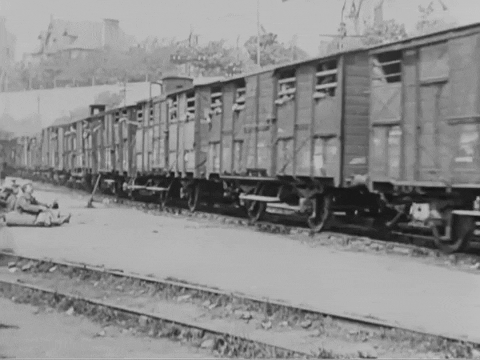
By the 1860s, the monumental task of connecting the East to the West was achieved with the First Transcontinental Railroad. This incredible feat, symbolized by the golden spike at Promontory Summit in Utah, stitched the fabric of the nation together, making cross-country travel faster and more accessible than ever before.
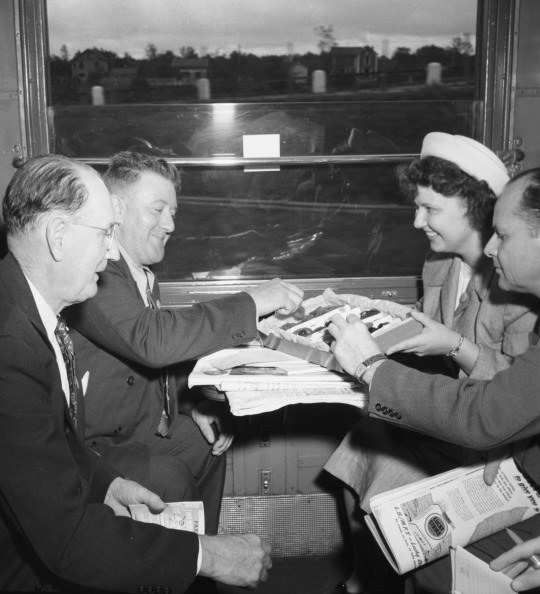
The golden age of railroads ushered in luxurious train journeys. Trains like the Pullman Sleeping Cars offered Americans unprecedented comfort, making long-distance travel not just bearable but enjoyable. Meanwhile, iconic stations like New York's Grand Central Terminal and D.C.'s Union Station became symbols of the grandeur and promise of rail travel.
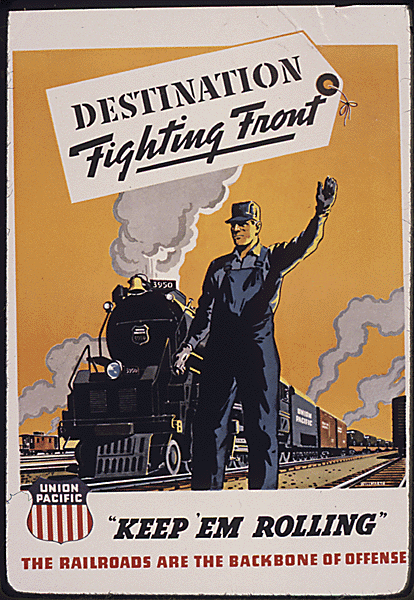
As the nation progressed, so did the role of trains. They were vital in transporting troops during wars, crucial for trade, and a lifeline for communities far from urban centers. However, with the advent of the 20th century and the rise of cars and airplanes, the prominence of train travel waned.
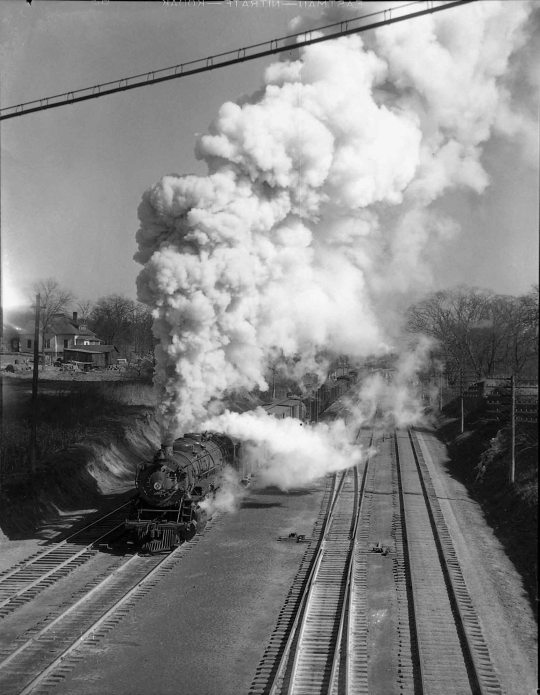
From the smoky beginnings in the 1800s to the streamlined trains of today, locomotives have been an integral part of America's journey, carrying not just people and goods, but dreams and hopes of a constantly evolving nation.
FURTHER READING:
Freedom Train https://prologue.blogs.archives.gov/2015/07/01/new-web-exhibit-on-the-freedom-train/
RFK Funeral Train
200 notes
·
View notes
Text
i don't mean to harp on about this but having to read things like " the way workers organize outside the NLRA" is making me feel like i am living through my worst nightmare
"critical industrial relations theory"

#apologize to the pullman porters right now i swear to god on everything........#THE RIGHT TO ORGANIZE IS NOT TRIVIAL? god.#STOP grantfishing#it is not like it is particularly easy to organize a union in the united states.#'But is it intersectional?' is some kimberle crenshaw takes a job at littler mendelson shit
3 notes
·
View notes
Text
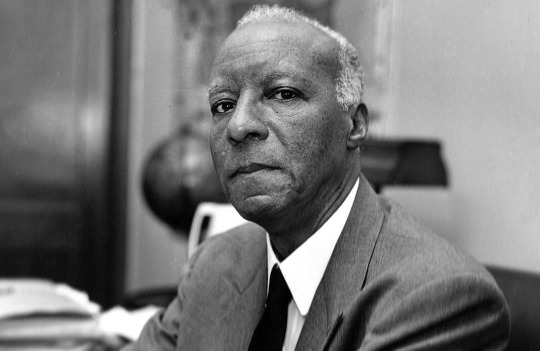
Today In History
Asa Philip Randolph, labor leader, and civil-rights leader, was born in Crescent City, FL, on this date April 15, 1889.
Randolph who was an influential figure in the struggle for justice and equality for African Americans. He was the organizer of the Brotherhood of Sleeping Car Porters, and began organizing that group of Black workers. At a time when half the affiliates of the American Federation of Labor (AFL) barred Blacks from membership, Asa Phillip Randolph took his union into the AFL.
Despite opposition, he built the first successful Black trade union; the brotherhood won its first major contract with the Pullman Company in 1937.
He warned Pres. Franklin D. Roosevelt that he would lead thousands of Blacks in a protest march on Washington, D.C.; Roosevelt, on June 25, 1941, issued Executive Order 8802, barring discrimination in defense industries and federal bureaus and creating the Fair Employment Practices Committee.
CARTER™️ Magazine carter-mag.com #wherehistoryandhiphopmeet #historyandhiphop365 #cartermagazine #carter #staywoke #asaphiliprandolph #blackhistorymonth #blackhistory #history
#asa phillip randolph#carter magazine#historyandhiphop365#wherehistoryandhiphopmeet#carter#history#cartermagazine#today in history#staywoke#blackhistory#blackhistorymonth
70 notes
·
View notes
Text

Riff Raff - Crime is a family affair. Riff Raff starring Jennifer Coolidge, Ed Harris, Gabrielle Union, Lewis Pullman, Pete Davidson, and Bill Murray is only in theaters February 28.
9 notes
·
View notes
Text

Early in the 20th century, Pullman Palace Car employed more African Americans than any other company in the United States. Most held jobs as sleeping car porters, caring for mostly white railroad passengers. Porters worked long hours with little rest, but they were well paid compared to other African Americans. In 1937, the Brotherhood of Sleeping Car Porters became the first African American union to win a labor agreement. Its members often became community leaders and civil rights activists.
93 notes
·
View notes
Text
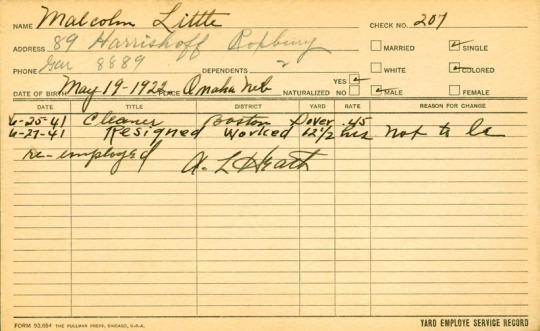
The Pullman Company, which manufactured and operated railroad cars, employed tens of thousands of Black porters from the 1860s to the 1960s. Pullman porters significantly influenced American labor history and the Civil Rights Movement, notably through the creation of the first all-Black union, the Brotherhood of Sleeping Car Porters. They also boast famous alumni, including one who became known under a different name: Malcolm X.
View Malcolm X's Pullman employee card
View all currently digitized Pullman employee cards
#pullman company#pullman porters#chicago#malcolm x#black history#labor rights#civil rights#railroads#newberry library#libraries#special collections#archives#newberryq
34 notes
·
View notes
Text
MOVIES WITH MEN IN UNDERWEAR (This is outdated- website shutdown early 2000’s)
“C”
Caddy, The (1953) Dean Martin walks into a darkened room in his white boxers, as everyone yells ‘Surprise!’ for a birthday celebration. Dean exits the room fast.
Caddyshack (1980) Michael O’Keefe
Cadence (1991) (Count a Lonely Cadence) (Stockade) Drama with endless scenes of Charlie Sheen, Laurence Fishburne and other US army prisoners in their army-issue white T-shirts and boxer shorts. Includes a long "emergency drill" scene out in a field at night, in the rain, with four of the six in only their underwear and boots.
Cagney & Lacey: True Convictions (1995) (TV) The women detectives go to arrest a guy at home, and he comes downstairs in his underwear.
Calendar Girl (1993) Jason Priestly, two other cute guys, mid movie, chase Marilyn Monroe to the beach and strip to boxers then naked; quick shot of his pecker.
Campus Man (1987) Making a male calendar. Lots of hunks
Candy (1968) Richard Burton is seen in wild-patterned silk boxer shorts.
Can't Hardly Wait (1998) After knocking them out with homemade chloroform, William's geeky friends strip him (Charlie Korsmo) and Mike (Peter Facinelli) to their underwear and take incriminating photos of them.
Can't Stop the Music (1980) Very bad Village People movie. Guys in briefs in the locker room scenes.
Canterville Ghost, The (1944) Robert Young and a platoon of men in their boxers and undershirts run around scared, as Charles Laughton haunts them. Robert Young boasts to the other soldiers on the army base. They pin him to the ground and take off his jumpsuit leaving him in white boxers and an undershirt. There's an extended scene where he hides behind the soldiers to make passerbys think he is clothed.
Cape Fear (1962) Suspense thriller. Robert Mitchum is subjected to a police strip search, but is unfazed and remains menacing in his full-cut white boxers and panama hat.
Cape Fear (1991) Robert DeNiro, searched by police, in red briefs.
Captain Ron (1992) Comedy. Kurt Russel in his briefs.
Car Wash (1976) Award-winning hit comedy. In early locker-room scene, guy drops his pants and shows his eye-catching white heart-spotted boxer shorts (and he seems to have something written on them). His co-workers immediately make fun and embarrass him - one holding the guy's trousers down so they can all get a good look.
Career Opportunities (1991) Comedy. Quick shot of a young guy in boxers and socks at the beginning of the movie; the same guy is later shown rollerblading around a department store wearing boxers.
Carnal Knowledge (1971) Jack Nicholson. Art Garfunkel was in his jocks too.
Carry On Constable (1960) A Street thief steals a bobbie’s suspenders, and his authoritarian trousers slip down while on patrol ... a comic scene indeed!
Casino (1995) Joe Pesci’s character and his brother were clubbed bloody before being stripped to their coloured Y-fronts and then buried alive. This happened near the end of the movie.
Casper (1995) Family comedy fantasy. Pullman is chased by ghosts. They grab swords and cry "All for one and one for all! Catch your pants before they fall!" They cut his belt, his pants fall down to his ankles, and he hops away in his boxers.
Casual Sex? (1988) Comedy. There are two good scenes with men in tighty whities.
Cat Ballou (1965) Comedy western. Lee Marvin in a white union suit, getting fitted for new clothes.
Catfish in Black Bean Sauce (2000) Comedy drama. We see Michael in his underwear and Dwayne in his boxers. Samantha then arrives and thinks that something is going on between the two men (there isn't).
Cell, The (2000) Suspense thriller. "We see Carl's father in his jockey underwear".
Chain of Passion [?] VERY hot scene at end of movie
Champ, The (1979) Jon Voight, though drunk, insists on taking off his own pants in this tear-jerker. Jon wears patterned full-cut boxer shorts in this scene.
Change of Heart (1938) Michael Whalen, wearing white boxers and garters, sews a button onto his trousers in from of Delmar Watson.
Chaplin (1992) Robert Downey, Jr. Quick scene of him in old fashioned boxers as he gets a costume together in studio wardrobe.
Charlie Chan at the Circus (1936) Chan’s #1 son gets temporarily kidnapped by gangsters, who pull him into car, strip him to A-shirt, striped boxers, shoes socks and garters, and then push him out of car in his underwear.
Chasers (1994) Billy McNamara in white briefs - two scenes - both great. Also has Tom Berenger in blue boxers. Billy’s pretty hot!
Chasing Amy (1997) Ben Affleck lying on the sofa with a naked Joey Lauren Adams. He is wearing boxers and some dirty looking white socks.
Checkered Flag (1990) Drama. Good rear view of guy's blue patterned boxer shorts in a stand-up, pants-down sex scene.
Chef! (1999) Documentary. A vigilante mob attack a 16-year-old boy who had stolen some chickens; the youth is stripped to his underpants and humiliated. "It is easy to imagine what might have developed if the filmmaker (Jean-Mari Teno) and his camera had not been present. Teno comments 'The paradox of this country is that the national sport - far more popular than soccer - is the plundering of resources by our heads and chiefs, yet a youth was nearly lynched for stealing one hen and four chicks'. Teno wonders if the powerless in the face of massive injustice take out their rage on those less powerful than themselves".
Choirboys, The (1977) Charles Durning and Asian guy go swimming in white briefs (Durning has a T-shirt). Locker room scenes too.
Chung King Express (1994) Romantic comedy drama. Nice cop (Tony Leung Chiu-Wai) in several scenes around his flat in white singlet and briefs.
City Heat (1984) 30s gangster comedy. Burt Reynolds in his underwear in a bedroom scene with Madeline Kahn. Also, an old guy glimpsed in the back of a car in his underwear, socks and garters, after Clint Eastwood steals his clothes, and another guy on a bed in underwear, socks and garters.
Class (1983) Comedy. In a prep-school prank near the start of the movie, Rob Lowe locks Andrew McCarthy out in the quadrangle in women's underwear. Lowe is also seen in pale boxers in a later scene.
Class Act (1992) Teen comedy. Christopher "Kid" Reid falling about in his white T-shirt and pale boxers, getting dressed for a date.
Clay Pigeons (1998) Clay goes to Amanda's house, but finds Lester (Vince Vaughn) there (in his underwear).
Clean and Sober (1988) Brian Benben (before "Dream On") climbs out of his sweatpants before Michael Keaton, revealing his classic white jockey briefs.
Clockwise (1986) Comedy. Headmaster John Cleese, needing clothes, has to go along with his student's plan: stopping in the woods, the schoolgirl gets Cleese to takes off his monk's habit, and persuades Michael Percival to strip to his underwear and put the habit on. Headmaster and schoolgirl then grab the guy's clothes and run to the car, Cleese in his underpants.
Clockwork Orange, A (1971) Alex (Malcolm McDowell) plods around in his underwear and is surprised to discover his "Post Corrective Adviser" Mr. Deltoid in the apartment. Deltoid is happy to have found the young boy before he has had a chance to get dressed.
Close Encounters of the Third Kind (1977) Richard Dreyfus is wearing his light blue boxers and is bent over a bathroom sink when his young son paddles his butt with a ping pong paddle. Richard makes a funny face in reaction.
Closer You Get, The (2000) Comedy. Kieran (Ian Hart), and Mickey (Dessie Gallagher) seen in their underwear.
Clown, The (1952) Red Skelton is a washed up comic who loves his little boy, Tim Constadine. Red displays himself in boldly striped full-cut boxer shorts.
Clownhouse (1988) (TV) A 13 year old boy walks around in only pajama bottoms, then wets his bed when frightened by a dream. In the morning his butt is seen as he puts on underwear. He is then seen in underwear and a tee shirt. Later he is seen taking a bath, but nothing is shown.
Clueless (1995) High-school comedy. Makes a great visual gag out of the way Dion’s way cute boyfriend Murray (Donald Faison) carries the low-slung jeans fashion to its extreme. You always think they’re about to fall, but sadly, as in real life, this never quite happens.
Coach (1978) Soaked after coming in from the rain, Michael Biehn strips down to blue briefs.
Coca-Cola Kid, The (1985) Erik Roberts sitting on the couch talking on the phone in WHITE briefs.
Cocktail (1988) Tom Cruise, in white Hanes. Nice.
Cold Heaven (1992) Long first scene is of James Russo in white briefs and a T-shirt. Later in the movie, Teresa Russell pulls his pants off him and pulls him onto the bed.
Cold Sweat (1993) This unremarkable thriller is brightened by the presence of Adam Baldwin. Baldwin kills a man, and then strips to his boxers while burying the corpse, to avoid leaving incriminating evidence.
Color of Night (1994) Bruce Willis in shorts, in the pool, totally nude--even shows his penis. Also a shower scene, and a scene with him being nude and putting on jeans.
Color Purple, The (1985) Multiple award winning drama, including, if memory serves, a scene where Danny Glover dashes back and forth in his underwear, demanding his wife find various items he needs.
Comfort of Strangers, The (1990) Several scenes of Rupert Everett in boxers and birthday suit.
Coming to America (1988) Romantic comedy. Glimpse Arsenio Hall in white singlet and blue undershorts when Eddie Murphy tells him to get up and pulls back the blankets.
Commando (1985) Action. Arnold Schwarzenegger, stripped down to his little brown bikini briefs, rows a boat ashore.
Coneheads (1993) Sci-fi comedy. Two earthlings are taken to the coneheads' planet and presented to the leader -- in their gartered socks, undershirts, and boxer shorts.
Conversation, The (1974) Gene Hackman changes his pants while talking to his landlady on the telephone, revealing that he’s wearing classic white jockeys.
Cool Hand Luke (1967) Tons of scenes of the prisoners in their underwear. Paul Newman always in boxers, one guy always in briefs.
Corruptor, The (1999) Vu (Byron Mann) in his underwear.
Corvette Summer (1978) A young Mark Hamill crawling around in a prostitute’s van, shows a good glimpse of lots of boxer shorts sticking out over the top of his jeans. A fun movie for Hamill fans. (Mark Hamill did this movie one year after Star Wars).
Cotton Comes to Harlem (1970) Comedy. Tall, blond cop is seduced by a woman who gets him to strip to his socks and underwear (print boxers, white undershirt) and eventually to nothing but his socks. She grabs his clothes and runs out of the apartment - he chases after her, but ends up embarrassingly locked out in the corridor in just his socks. Another underwear scene follows immediately as cops question a guy in his print boxers and dirty white undershirt.
Coupe de Ville (1990) Comedy/drama. Two scenes with co-lead in white briefs - once as a young boy, and then ten or fifteen years later.
Courage Under Fire (1996) Lou Diamond Phillips wearing only a jock strap. Nice shot of him from the side as he pulls up shorts over his firm bare ass (tan line visible).
Cowboy Way, The (1994) Action/Comedy. Woody Harrelson in underwear a couple of times, and also a nice butt shot.
Creator (1985) Vincent Spano in white boxers, twice.
CrissCross (1992) David Arnott (very cute) gets out of bed wearing only his briefs. It’s kind dark, but still nice.
Crow, The (1994) Supernatural revenge fantasy. In a scene lasting several minutes, Eric Draven (Brandon Lee) pays a visit to sympathetic cop Albrecht (Ernie Hudson) at his home. This handsome, black police officer is in his cop cap and underwear - white T-shirt, grey-striped boxer shorts.
Cruel Intentions (1999) Sebastian finds Blaine (Joshua Jackson) and Greg (Eric Mabius) in bed together, both in their underwear, and takes a picture to blackmail Greg. Sebastian enters Kathryn's room to find her in bed and a guy under the bed, whom we then see leaving in his underwear.
Cruising (1980) Pacino calls at a door which is opened by a guy wearing a white trimmed blue pair of Jockey briefs and a matching singlet (A-shirt). Good long shots of the Y-front, buttocks and chest.
Crush, The (1993) Alicia Silverstone taking off her underwear while he is hiding in the closet. (huh?)
Cry-Baby (1990) Johnny Depp. Great scene of Depp hanging from ceiling showing his FOLs. Writer-director John Waters revealed that Depp wore not one but three pairs of underpants for the 'whoops-we've-gratuitously-ripped-his-trousers-off' scene. No unsightly bulges there!
Cuba (1979) Drama. Handsome young Cuban man comes home, strips as he crosses the lawn, and dives into the swimming pool in his trim white boxer shorts.
Curse, The (1987) Wil Wheaton is seen at 14 in only underwear.
Cutting Edge, The (1992) DB Sweeney in white boxers at beginning.
8 notes
·
View notes
Text

Dr. Millie Louise Bown Russell (October 29, 1926 - November 1, 2021) was born in Seattle to Augustus and Edith Bown, a Pullman Porter and beautician. She was born in Seattle, one of seven children. Both parents were local political activists, especially after Augustus became a member of the Longshoremen’s Union. Paul Robeson and Marian Anderson were among the visitors to the Bown home.
She became the first African American student in the Medical Technology program at Seattle University. She graduated with a BS in Biology. She married Ed Russell. They had four children.
She worked for the King County Central Blood Bank and its successor, the Puget Sound Regional Blood Center. She returned to Seattle University as a student and received a secondary science-teaching certificate. She received an MS in Kinesiology from the University of Washington. She received a Ph.D. in Education from UW.
She began working at the University of Washington as the Director of the Preprofessional Program for Minority Students in Health Sciences. She became Assistant to the Vice President of the Office of Minority Affairs. Her career at the University of Washington encompassed more than three decades.
The establishment of the Seattle-Mombasa (Kenya) Sister City Association has provided several opportunities to explore African life and culture. She founded the Early Scholars Outreach Program. The Early Program was the inspiration for the national GEAR UP program that now serves thousands of pre-college students across the state of Washington.
The City of Seattle named October 29 Dr. Millie Russell Day. She was honored with the University of Washington’s Outstanding Public Service Award. The University of Washington Office of Minority Affairs and Diversity established the Dr. Millie Russell Endowed Scholarship in honor of her lifelong devotion to education and equality. The Dr. Millie Russell Endowed Scholarship will benefit underrepresented, low-income, first-generation students interested in studying science. #africanhistory365 #africanexcellence #alphakappaalpha
5 notes
·
View notes
Text
Workers Rights: Earned in Blood
(A Brennan Lee Mulligan style rant)

Oh, you think the working class has gotten a single goddamn thing in history by asking nicely? By politely inquiring, “Excuse me, sir, might I have a livable wage? Perhaps a lunch break where I don’t have to inhale toxic fumes? Maybe, just maybe, you could stop shooting us when we say the word ‘union’ too loud?”
No, never! Not once! The people who own the mines, the factories, the railroads, the land, they do not care! They will squeeze every last drop of labor from your body until you’re a lifeless husk unless you—WE—make it so that it costs them more to keep squeezing than to let go.
Let’s talk about Blair Mountain. You think those miners took up arms against the coal barons because they were just so excited to reenact the goddamn Civil War in West Virginia? No! It was because the company stores kept them in debt, the mine bosses kept them in danger, and the law—supposedly an institution of the people—sent goddamn Baldwin-Felts thugs to evict their families at gunpoint when they tried to unionize. The government, the one that’s supposed to protect its people? It bombed them. Dropped literal bombs on workers whose crime was demanding a wage that let them eat.
The police? Oh, buddy, let’s talk about the cops. Pinkertons, Baldwin-Felts, private security goons, modern union-busting consultants, whatever branding they slap on it, the job is the same: to break strikes, to keep capital safe, and to crush solidarity. The cops weren’t called to keep the peace when workers at the Pullman Company went on strike. No, they were there to break heads and break ranks—to make sure the workers stayed scared and divided. Hell, half the time they don’t even tell the strikebreakers—the scabs—what they’re walking into! They lie, they manipulate, they recruit people desperate enough to take a job without knowing that it means crossing a picket line until they’re already there. And when tensions boil over? When violence happens? It’s never the bosses who get their skulls cracked open.
You cannot ask capital to be kind. You cannot politely request that the billionaire class develop empathy. You think Andrew Carnegie accidentally let the Homestead strikers bleed out in the streets? You think Jeff Bezos forgot that his warehouses are sweatshops? No. They choose profit over human life, every time, and the only reason they ever back down is when we—the workers, the people who actually make the world function—force them to.
So yeah, history proves one thing: solidarity works. Strikes work. Direct action works. And the only thing that doesn’t? Asking nicely.
#politics#leftist#america#political theory#activism#usa#workers rights#working class#owning class#brennan lee mulligan#rant#direct action#nothing to loss but your chains
6 notes
·
View notes
Text
did you guys know that um. there is a train. it leaves the station at a quarter after five and it’s direct from union terminal right there at public square a quarter after five and where does it arrive at grand central station the cleveland limited of new york central railroad has first class pullman cars for big time movie stars and we’re gonna take one!!!!!!
66 notes
·
View notes